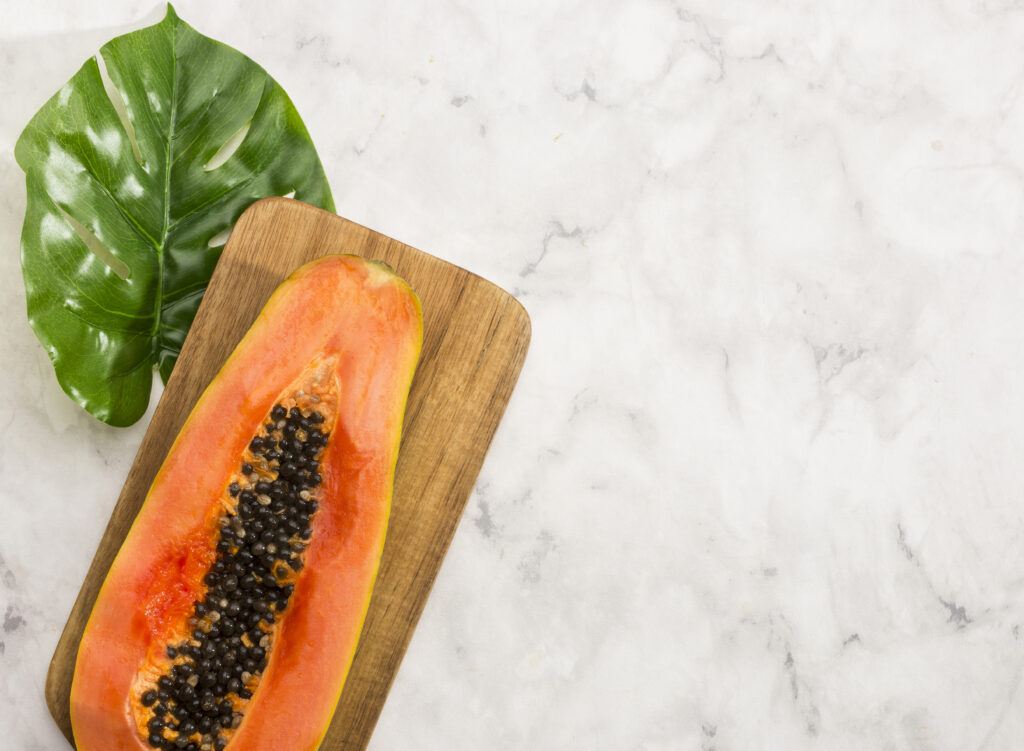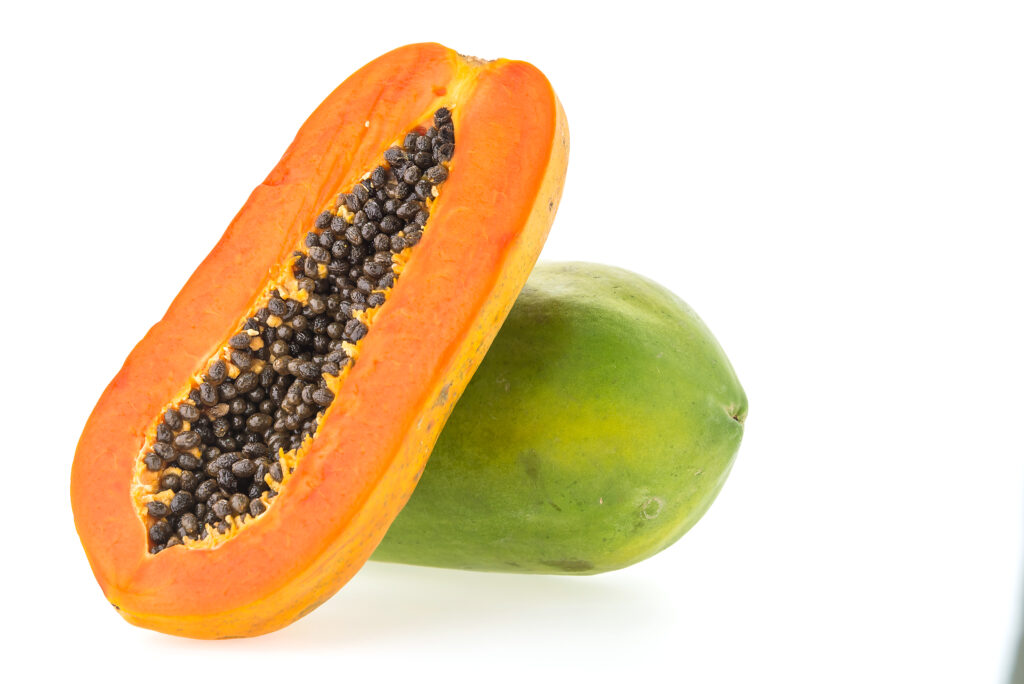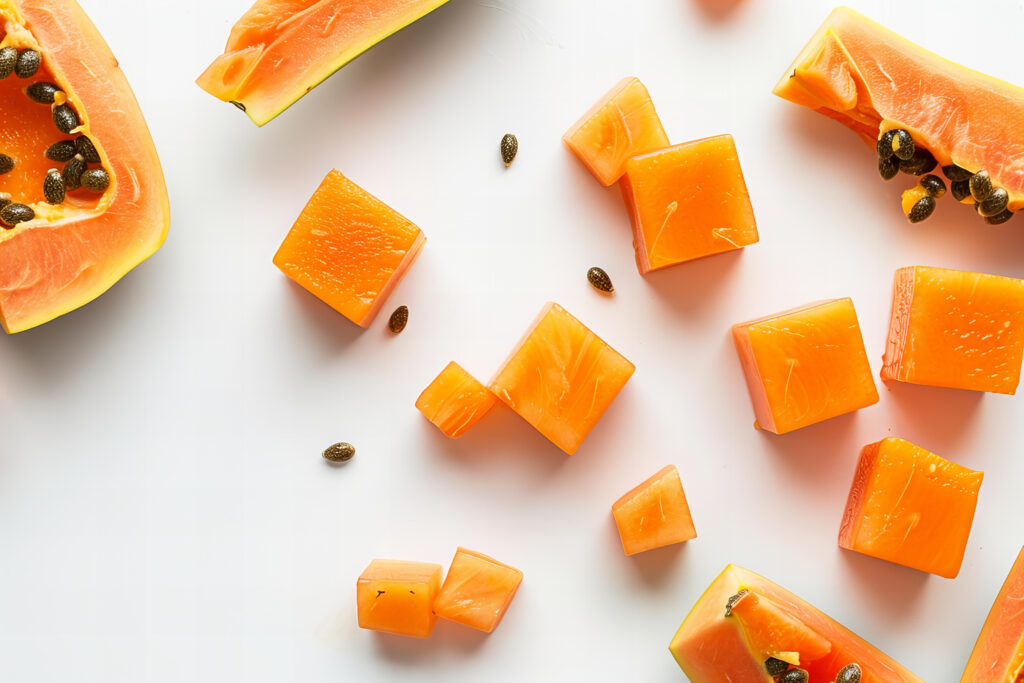Table of Contents
When it comes to tropical fruits that taste fantastic and provide so many health benefits, papaya has no competition. Papaya is a showstopper with its orange color, buttery texture, and sweet, musky flavor. In addition to tasting great in the kitchen, health benefits of papaya a nutritional powerhouse and has made its way into all kinds of diets for generations. Originally from Central America and Southern Mexico, papaya is now grown in most tropical and subtropical places around the world; India is currently master, but it’s grown growing in many countries.
Whether you’re eating in ripe and raw in a smoothie, adding green (unripe) papaya to a savory salad, or using its enzymes to tenderize your meat naturally, it is a versatile fruit that should make regular appearances in your dietary repertoire. This guide will give you everything you need to know to enjoy papaya: a summary of its significant health benefits of papaya, nutrition facts, possible side effects, and some fun ways to incorporate health benefits of papaya into your daily diet as a tropical superfruit!
These posts are very useful for your diet journey- Ice apple benefits, Star fruit benefits, Pineapple benefits…and more posts in health-icon.com

Top 10 Health Benefits of Papaya
1. Improves Digestive Health
Papaya contains papain, a powerful digestive enzyme that digests the long protein chains that are present in meats and other protein sources to make them easier to digest. Papain is such a good digestive enzyme it is used commercially as a meat tenderizer. If you are dealing with hemorrhoids, constipation, or symptoms of irritable bowel syndrome (IBS), papaya can help with bowel regularity and relieve bloating. Health benefits of papaya contains a substantial amount of fiber, which is important for digestive health, as it adds bulk to stool and promotes a healthy gut microflora.
2. Boosts Immune Function
Eating one serving of health benefits of papaya exceeds the daily recommendation of vitamin C, which is a strong antioxidant that assists the immune system. Vitamin C supports the production of some white blood cells to help your body fight off bacteria and viral infections. Vitamin C also creates a stronger barrier in the skin, helping to prevent pathogens from entering your bloodstream. Eating foods rich in vitamin C, like papaya, may reduce the severity and duration of the common cold and flu.
3. Provides Powerful Antioxidant Protection
Health benefits of papaya is rich in antioxidants like carotenoids, especially lycopene, flavonoids, and other important compounds. These antioxidants counteract free radicals—unstable molecules that can lead to oxidative stress and cell damage and are thought to contribute to chronic disease and aging. Research indicates that fermented papaya can substantially lower markers of oxidative stress in a number of groups ranging from older adults to prediabetics.
4. Supports Heart Health
Due to its potassium, fiber, vitamin C, and antioxidant content, health benefits of papaya is particularly beneficial to cardiovascular health. Fiber can help decrease levels of cholesterol, while potassium supports normal blood pressure. Antioxidants can help stave off oxidation of cholesterol, an important stage in the development of plaques in the arteries. Health benefits of papaya also supplies folate, which aids conversion of homocysteine (an amino acid that may be damaging to blood vessels when its levels are high) to less damaging compounds.
5. Provides Anti-Inflammatory Benefits
Chronic inflammation is associated with a variety of diseases, and the anti-inflammatory properties in papaya may help alleviate this silent condition. The enzymes papain and chymopapain, as well as numerous other antioxidants, reduce inflammation throughout the body. This may be especially helpful for individuals with chronic inflammatory conditions, such as arthritis, asthma, or autoimmune conditions. Studies have demonstrated that increased consumption of carotenoid-rich fruits like papaya can reduce inflammatory markers in the body.
6. Promotes Skin Health and Anti-Aging
The vitamin C and lycopene in health benefits of papaya can protect skin from free radical damage that can contribute to wrinkles, sagging, and signs of aging skinn. Vitamin C also plays a key role in the production of collagen, the protein responsible for skin firmness and elasticity. Studies have demonstrated that both lycopene and vitamin C, both found in papaya, reduced the average depth of facial wrinkles and prevented sunburns. Topically applying health benefits of papaya also features prominently in natural skincare via its natural exfoliating qualities.
7. May Have Anticancer Properties
Preliminary research suggests that the lycopene and other antioxidants found in health benefits of papaya might have anticancer properties. Several test tube and animal studies have established that lycopene in health benefits of papaya helps reduce cancer risk, and some researchers have focused their studies on the ability of fermented papayas to reduce oxidative damage in people who have precancerous conditions.
When researchers looked at 14 fruits and vegetables containing a known antioxidant, health benefits of papaya was the only fruit found to have anticancer properties against breast cancer cells. Fiber in papaya may also be somewhat protective against colon cancer because dietary fiber binds to toxins and removes them from the body.
8. Supports Eye Health
Health benefits of papaya is an excellent source of vitamin A and other compounds, such as lutein and zeaxanthin, which are important for good vision health. Vitamin A protects against night blindness and also keeps the eyes’ corneas clear. Lutein and zeaxanthin help filter out harmful blue light, and protect the retina from oxidative damage during the aging process. Regular consumption of health benefits of papaya may help support the prevention of age-related macular degeneration—the leading cause of irreversible vision loss among older adults.
9. Improves Bone Health
Health benefits of papaya offers vitamin K, which is important for bone health by increasing calcium absorption and decreasing calcium loss through urine. Getting enough vitamin K may help reduce the overall risk of fractures and osteoporosis. Additionally, the various anti-inflammatory substances in health benefits of papaya can also help reduce joint pain and stiffness associated with inflammatory conditions like arthritis.
10. Supports Healthy Weight Management
Inflated water content, important fiber, and the amount of calories make papaya a great food for weight management. The high fiber content helps you feel full, and the natural sweetness replaces sugar in your diet. Enzymes in health benefits of papaya also promote healthy digestion and absorption of nutrients, and can also help promote metabolic health.

Papaya Nutrition Fact 100g
The following is a complete nutritional breakdown of fresh papaya per 100g serving and consume health benefits of papaya:
| Nutrient | Amount Per 100g |
| Calories | 43 kcal |
| Carbohydrates | 10.8 g |
| Fiber | 1.7 g |
| Sugars | 7.8 g |
| Protein | 0.5 g |
| Fat | 0.3 g |
| Vitamin C | 60.9 mg |
| Vitamin A | 47 µg |
| Folate | 37 µg |
| Potassium | 182 mg |
| Magnesium | 21 mg |
| Calcium | 20 mg |
| Beta-Carotene | 274 µg |
| Lycopene | 1828 µg |
NOTE: The nutritional values herein may vary some dependent upon variety and ripeness of papaya.
This remarkable nutritional profile provides impressive percentages of a day’s requirement of many essential nutrients, and is also low in calories, which makes health benefits of papaya an outstanding addition to a nutritious diet.
Papaya Tree: A Botanical Wonder
The papaya tree (Carica papaya) is a quickly-growing tropical tree species that is able to provide fruit ideal conditions throughout all seasons. While some may call this species a tree based upon its hard, woody structure, in fact, the papaya is a herbaceous plant because true trees produce woody-tissue.
Physical Characteristics
Papaya trees are generally unbranched to branchless and range from about 5 to about 10 meters tall (16-33 feet tall). The trunk is erect and hollow, and bears very obvious scars from the leaves and fruit leaves. The leaves are extremely large, being 50-70 cm (20-28 inches) in diameter, and palmately lobed with 7 distinguishable lobes. Papaya latex occurs in articulated laticifers in all portions of the plant and produces a milky sap.
Flowers
Possibly the most interesting characteristic of papaya is that it has three types, male, female, and hermaphroditic. Male trees produce pollen, but they never produce fruit. Female trees produce fruits but they need pollen from male trees. Hermaphroditic trees produce perfect/floral flowers with both male and female flower organs and can self-pollinate resulting in the fruits that are preferred commercially. This variability is both fascinating for plant biologists and for farmers producing this crop.
Fruit Development
The papaya fruit, classified as a large berry, can reach lengths of 15-45 cm (6-18 inches) and widths of 10-30 cm (4-12 inches). Papaya fruit grows from the ovary of the flower and takes roughly 22-26 weeks to develop. When ripe, the fruit turns from green to amber or orange, and the pulp becomes soft with a buttery texture. The central cavity of the fruit contains many black, wrinkled edible seeds that taste bitter.
Growing Requirements
Papaya grows well in tropical climates, during warm seasons, at temperatures between 21-33°C (70-91°F). Papaya trees require well-draining soil with pH levels of 5.5-6.5. Papaya trees are very sensitive to frost and water logging. Papaya trees are also susceptible to strong wind because of shallow roots and non-woody trunks. With proper care, papaya trees can bear fruit between 6-12 months and can continue to produce for several years; though, many commercial plantations are replaced every 3 years to maximize production.

Raw Papaya Side Effects
Even though papaya has many health benefits, there are some important considerations to be aware of, particularly regarding unripe (raw) papaya:
• Pregnancy concerns: Unripe papaya contains latex, which has papain—a natural enzyme that may stimulate contractions and potentially increase the risk for miscarriage, particularly in early pregnancy. In addition, the pepsin and papain content in unripe papaya might inhibit some fetal growth. Pregnant women should avoid eating unripe papaya altogether, but should speak with their healthcare provider concerning safe consumption of ripe papaya.
• Gastrointestinal issues: Eating too much unripe papaya may cause stomach cramping, diarrhea, or some other discomfort due to the high fiber content and/or powerful enzymes which can irritate the stomach lining—particularly in sensitive individuals. Those with sensitive digestive systems should consider consuming papaya in moderate amounts and to gradually introduce papaya into their diet.
• Potential esophageal damage: The latex content in unripe papaya has large amounts of papain, which in excessive amounts, may irritate or damage the esophagus. However, the concern is mostly with concentrated papain supplements rather than occasional consumption of papaya fruit.
• Allergic reactions: Some rare individuals may experience allergic reactions to papaya, particularly in individuals who have latex allergies (a known condition called latex-fruit syndrome). Symptoms may include itching and/or swelling or even dizziness or difficulty breathing.
• Medication Interactions. The interactions of medications with ripe papaya are not well documented, however, there is potential for vitamin K from papaya to interact with blood thinners like warfarin, therefore those on blood-thinners need to eat papaya consistently each day and speak with their physician.
Most people can consume ripe papaya, and it is safe in moderate amounts, but if you have specific health conditions or concerns always discuss with a healthcare professional.
How to Select, Store, and Enjoy Papaya
How to Select a Papaya
When selecting papaya, choose fruits that are mostly yellow to orange-red (with a few green spots being acceptable). The skin should give slightly when gently pressed, like a ripe avocado without being overly soft or mushy. Avoid fruits with excessive bruising, extreme dark spots, or mold. Green papayas are acceptable if you are going to cook it or use it in a recipe (like a salad).
Proper Storage Methods
Unripe green papayas are fine to sit at room temperature until they develop their colors and slight softening. Once ripe, papayas should be moved to the refrigerator to slow ripening down and best preserve flavor. Ripe papayas can be peeled, cubed, and frozen to have on hand for smoothies or desserts.
Delicious Ways to Enjoy Papaya
- Breakfast delight: Cut a papaya in half, scoop out the seeds, and fill with Greek yogurt, topped with berries and chopped nuts.
- Refreshing salads: Combine diced papaya with avocado, cooked chicken, and a light vinaigrette for a tropical twist on chicken salad.
- Traditional green papaya salad: Shred unripe papaya and toss with fish sauce, lime juice, chilies, garlic, and peanuts for a classic Southeast Asian dish.
- Nutritious smoothies: Blend ripe papaya with banana, coconut milk, and ice for a creamy tropical smoothie.
- Flavorful salsas: Dice papaya and combine with tomatoes, onions, cilantro, and lime juice for a sweet and tangy salsa perfect for grilled fish or chicken.
- Homemade pickles: Pickle shredded green papaya with garlic, mustard seeds, and lemon juice for a tangy condiment.
Conclusion
Papaya can genuinely be labeled a superfruit due to its powerful nutrient profile, health benefits of papaya, and versatility in the kitchen. Whether you’re looking to improve your digestion, elevate your immune system, enhance your heart health, or simply enjoy a nutritious and delicious fruit, papaya will provide a natural and satisfying experience.
If you add this tropical treasure to your regular diet, taking care to consider any necessary precautions, you will certainly be able to obtain its many health benefits of papaya and satisfy your taste buds. The next time you’ll be shopping at the grocery store or farmers’ market, don’t hesitate to pick up one of these “fruits of the angels” to discover why this fruit has been treasured for thousands of years around the world!
Have you tried papaya? How do you enjoy this tropical superfruit? Please share your experiences or recipes below!
FAQs
What are the main health benefits of papaya?
Papaya is a nutritional powerhouse. It is renowned for aiding digestion due to the enzyme papain, which helps break down proteins. It’s also incredibly rich in vitamin C and antioxidants like lycopene, which can reduce inflammation, support heart health, protect your vision, and may even have anti-cancer properties.
Is it safe to eat papaya during pregnancy?
Ripe papaya is generally considered safe to eat in food amounts. However, unripe or semi-ripe papaya contains high levels of latex, which can stimulate contractions and pose a risk of complications. Pregnant women should consult a healthcare professional before consuming papaya.
Can papaya cause any side effects?
For most people, ripe papaya is safe. However, overconsumption can lead to stomach upset due to its high fiber and papain content. Those with latex allergies may also be allergic to papaya. Additionally, papaya may lower blood sugar and interact with blood-thinning medications, so those with diabetes or on medication should use caution.
How can I tell if a papaya is ripe and how do I eat it?
A ripe papaya should be yellow to orange-red in color and yield slightly to gentle pressure, similar to a ripe avocado. To eat it, cut it in half lengthwise, scoop out the seeds, and scoop out the flesh with a spoon. It can be enjoyed on its own, in smoothies, salads, salsas, and desserts.